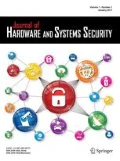Abstract
With the global spanning of integrated circuit (IC) and electronic device supply chains, the ability of an untrusted foundry to alter a design for intellectual property (IP)/IC piracy increases. To tackle this threat, this paper proposes a design-based fingerprinting methodology based on machine learning schemes. The proposed method considers the effect of process variations, measurement noise, and device aging. The proposed fingerprinting scheme can identify if the circuit is original or has been altered by an adversary to hide piracy. Changing a gate to an equivalent counterpart does not change the functionality of the circuit and we assess these as altered circuits. Altering the circuit can arise if an adversary gains access to the register-transfer level (RTL) or netlist of a design in an untrusted supply chain or uses the datasheet to implement a functionally equivalent design. Experimentally we determine that our method can detect a pirated chip with near 100% accuracy when classifying new ICs, and above 96% accuracy when classifying at any age up to 7 years in the presence of noise if at least 2.5% of the gates in the IC have been altered by an adversary.









Similar content being viewed by others
References
Tehranipoor M, Koushanfar F (2010) A survey of hardware trojan taxonomy and detection. IEEE Des Test of Comput 27(1):10–25. https://doi.org/10.1109/MDT.2010.7
Liu B, Jin Y, Qu G (2015) Hardware design and verification techniques for supply chain risk mitigation. In: International Conference Computer-Aided Design and Computer Graphics (CAD/Graphics), pp 238–239. https://doi.org/10.1109/CADGRAPHICS.2015.53
Ni M, Gao Z (2004) Watermarking system for IC design IP protection. International Conference on Communications, circuits and system vol 2, pp 1186–1190. https://doi.org/10.1109/ICCCAS.2004.1346387
Marchand C, Bossuet L, Jung E (2014) IP watermark verification based on power consumption analysis. In: IEEE International System-on-Chip Conf. (SOCC), pp 330–335. https://doi.org/10.1109/SOCC.2014.6948949
Shey J, Karimi N, Robucci R, Patel C (2018) Design-based fingerprinting using side-channel power analysis for protection against IC piracy. In: Proceedings of IEEE International Symposium on VLSI ISVLSI
Rostami M, Koushanfar F, Karri R (2014) A primer on hardware security: models, methods, and metrics. Proc IEEE 102(8):1283–1295. https://doi.org/10.1109/JPROC.2014.2335155
Liu M, Kim CH (2017) A powerless and non-volatile counterfeit IC detection sensor in a standard logic process based on an exposed floating-gate array. In: Symposium on VLSI Technology, pp T102–T103. https://doi.org/10.23919/VLSIT.2017.7998211
Newbould RD, Carothers JD, Rodriguez JJ, Holman WT (2002) A hierarchy of physical design watermarking schemes for intellectual property protection of IC designs. In: IEEE International Symposium Circuits and System, pp IV–862–IV–865 https://doi.org/10.1109/ISCAS.2002.1010594
Bai F, Gao Z, Xu Y, Cai X (2007) A watermarking technique for hard IP protection in full-custom IC design. in: Int. Conf. Comms, Circuits and Systems, pp 1177–1180. https://doi.org/10.1109/ICCCAS.2007.4348256
Xu W, Zhu Y (2011) A digital copyright protection scheme for soft-IP core based on FSMs. in: Int. Conf. Consumer Electronics, Communications and Networks (CECNet), pp 3823-3826. https://doi.org/10.1109/CECNET.2011.5768225
Echavarria J, Morales-Reyes A, Cumplido R, Salido MA (2014) FSM merging and reduction for IP cores watermarking using genetic algorithms. In: International Conference on ReConFigurable Computing and FPGAs (ReConFig14), pp 1–7. https://doi.org/10.1109/ReConFig.2014.7032525
Lin M, Tsai G, Wu C, Lin C (2007) Watermarking technique for HDL-based IP module protection. In: International Conf. on intelligent information hiding and multimedia signal processing (IIH-MSP 2007), vol 2, pp 393–396. https://doi.org/10.1109/IIH-MSP.2007.326
Huang X, Cui A, Chang C (2017) A new watermarking scheme on scan chain ordering for hard IP protection. In: IEEE International Symposium on Circuits and Systems (ISCAS), pp 1–4. https://doi.org/10.1109/ISCAS.2017.8050823
Qu G (2002) Publicly detectable watermarking for intellectual property authentication in VLSI design. IEEE Trans Comput-Aided Des Integr Circ Syst 21(11):1363–1368. https://doi.org/10.1109/TCAD.2002.804205
Yu Q, Dofe J, Zhang Z (2017) Exploiting hardware obfuscation methods to prevent and detect hardware trojans. In: IEEE International Midwest Symposium on Circuits and System (MWSCAS), pp 819–822. https://doi.org/10.1109/MWSCAS.2017.8053049
Koteshwara S, Kim CH, Parhi KK (2018) Key-based dynamic functional obfuscation of integrated circuits using sequentially triggered mode-based design. IEEE Trans Inf Forens Secur 13(1):79–93. https://doi.org/10.1109/TIFS.2017.2738600
Wei S, Nahapetian A, Potkonjak M (2011) Robust passive hardware metering. In: IEEE/ACM International Conference Computer-Aided Design (ICCAD), pp 802–809. https://doi.org/10.1109/ICCAD.2011.6105421
Koushanfar F (2012) Hardware metering: a survey, pp 103–122. Springer, New York. https://doi.org/10.1007/978-1-4419-8080-9_5
Chakraborty RS, Bhunia S (2009) Harpoon: an obfuscation-based soc design methodology for hardware protection. IEEE Trans Comput-Aided Des Integr Circ Syst 28(10):1493–1502. https://doi.org/10.1109/TCAD.2009.2028166
Roy DB, Bhasin S, Nikolić I, Mukhopadhyay D (2019) Combining puf with rluts: a two-party pay-per-device ip licensing scheme on fpgas. ACM Trans Embed Comput Syst 18(2):12:1–12:22. https://doi.org/10.1145/3301307
Agrawal D, Baktir S, Karakoyunlu D, Rohatgi P, Sunar B (2007) Trojan detection using IC fingerprinting. In: IEEE Symposium Security Privacy, pp 296–310. https://doi.org/10.1109/SP.2007.36
He J, Zhao Y, Guo X, Jin Y (2017) Hardware trojan detection through chip-free electromagnetic side-channel statistical analysis. IEEE Trans Very Large Scale Integr (VLSI) Syst 25(10):2939–2948. https://doi.org/10.1109/TVLSI.2017.2727985
Jin Y, Makris Y (2008) Hardware trojan detection using path delay fingerprint. In: IEEE International Workshop on Hardware-Oriented Security and Trust, pp 51–57. https://doi.org/10.1109/HST.2008.4559049
Vaikuntapu R, Bhargava L, Sahula V (2016) Golden IC free methodology for hardware trojan detection using symmetric path delays. In: International Symposium on VLSI Design and Test (VDAT), pp 1–2. https://doi.org/10.1109/ISVDAT.2016.8064895
Huang K, Liu Y, Korolija N, Carulli JM, Makris Y (2015) Recycled IC detection based on statistical methods. IEEE Trans Comput-Aided Des Integr Circ Syst 34(6):947–960. https://doi.org/10.1109/TCAD.2015.2409267
Guo Z, Xu X, Rahman MT, Tehranipoor MM, Forte D (2018) SCARe: an SRAM-based countermeasure against IC recycling. IEEE Trans Very Large Scale Integr (VLSI) Syst 26(4):744–755. https://doi.org/10.1109/TVLSI.2017.2777262
Guin U, Forte D, Tehranipoor M (2016) Design of accurate low-cost on-chip structures for protecting integrated circuits against recycling. IEEE Trans Very Large Scale Integr (VLSI) Syst 24(4):1233–1246. https://doi.org/10.1109/TVLSI.2015.2466551
Guerin C, Huard V, Bravaix A (2007) The energy-driven hot-carrier degradation modes of nMOSFETs. IEEE Trans Device Mater Rel 7(2):225–235. https://doi.org/10.1109/TDMR.2007.901180
Tsetseris L, Zhou XJ, Fleetwood DM, Schrimpf RD, Pantelides ST (2005) Physical mechanisms of negative-bias temperature instability. Appl Physics Lett. https://doi.org/86:142103-142105
Rosa GL, Guarin F, Rauch S, Acovic A, Lukaitis J, Crabbe E (1997) NBTI-channel hot carrier effects in PMOSFETs in advanced CMOS technologies. In: Proceedings of IEEE International Reliability Physics Symposium, pp 282–286. https://doi.org/10.1109/RELPHY.1997.584274
Karimi N, Huang K (2016) Prognosis of NBTI aging using a machine learning scheme. In: IEEE International Symposium Defect and Fault Tolerance VLSI and Nanotechnology Systems (DFT), pp 7–10. https://doi.org/10.1109/DFT.2016.7684060
Karimi N, Danger JL, Guilley S (2018) Impact of aging on the reliability of delay pufs. J Electron Test (JETTA) 34(5):571–586. https://doi.org/10.1007/s10836-018-5745-6
Zhou C, Jenkins KA, Chuang PI, Vezyrtzis C (2018) Effect of HCI degradation on the variability of MOSFETS. In: IEEE International Relations in Physics Symposium (IRPS), pp P–RT.1–1–P–RT.1–4. https://doi.org/10.1109/IRPS.2018.8353684
Ziel AVD (1962) Thermal noise in field-effect transistors. Proc IRE 50(8):1808–1812. https://doi.org/10.1109/JRPROC.1962.288221
Hung KK, Ko PK, Hu C, Cheng YC (1990) A unified model for the flicker noise in metal-oxide-semiconductor field-effect transistors. IEEE Trans Electron Dev 37(3):654–665. https://doi.org/10.1109/16.47770
Brglez F, Fujiwara H (1985) A neutral netlist of 10 combinational benchmark circuits and a targeted translator in FORTRAN. In: IEEE International Symposium Circuits and System (ISCAS)
NanGate, Inc (2018) NanGate FreePDK45 open cell library. http://www.nangate.com/?page_id=2325
Synopsys, Inc (2018) MOS device aging analysis with HSPICE and CustomSim. https://www.synopsys.com/content/dam/synopsys/verification/white-papers/mosra-wp.pdf
Karimi N, Chakrabarty K (2013) Detection, diagnosis, and recovery from clock-domain crossing failures in multiclock SoCs. IEEE Trans Comput-Aided Des Integr Circ Syst 32(9):1395– 1408
Hwang EJ, Kim W, Kim YH (2009) Impact of process variation on timing characteristics of mtcmos flip-flops for low-power mobile multimedia applications. In: Proceedings of International Symposium Integrated Circuits, pp 332–335
Mahor V, Chouhan A, Pattanaik M (2012) A novel process variation tolerant wide fan-in dynamic or gate with reduced contention. In: International Conference on Computers and Devices for Communication (CODEC), pp 1–4. https://doi.org/10.1109/CODEC.2012.6509271
Chang D, Ozev S, Sinanoglu O, Karri R (2014) Approximating the age of RF/analog circuits through re-characterization and statistical estimation. In: Design, Automatic and Test in Europe Conference on (DATE), pp 1–4. https://doi.org/10.7873/DATE.2014.048
Huang GB, Zhou H, Ding X, Zhang R (2012) Extreme learning machine for regression and multiclass classification. IEEE Trans Syst Man Cybern Syst 42(2):513–529. https://doi.org/10.1109/TSMCB.2011.2168604
Hsu CW, Lin CJ (2002) A comparison of methods for multiclass support vector machines. IEEE Trans Neural Netw 13(2):415–425. https://doi.org/10.1109/72.991427
Celio C, Chiu P, Asanović K, Nikolić B, Patterson D (2019) Broom: an open-source out-of-order processor with resilient low-voltage operation in 28-nm cmos. IEEE Micro 39(2):52–60. https://doi.org/10.1109/MM.2019.2897782
RISC-V Foundation (2019) RISC-V cores. https://riscv.org/risc-v-cores/
Cong J, Lim SK (2004) Edge separability-based circuit clustering with application to multilevel circuit partitioning. IEEE Trans Comput-Aided Des Integr Syst 23(3):346–357. https://doi.org/10.1109/TCAD.2004.823353
Kadiyala Rao S, Robucci R, Patel C (2014) Simulation based framework for accurately estimating dynamic power-supply noise and path delay. J Electron Test 30(1):125–147. https://doi.org/10.1007/s10836-013-5425-5
Singh A, Plusquellic J, Phatak D, Patel C (2006) Defect simulation methodology for iDDT testing. J Electron Test 22(3):255–272. https://doi.org/10.1007/s10836-006-9318-8
Yun Y, Kim J, Kim N, Min B (2011) Beyond UVM for practical SoC verification. In: 2011 International SoC Design Conference, pp 158–162. https://doi.org/10.1109/ISOCC.2011.6138671
Acknowledgments
We would like to thank Brien Croteau for his help developing ideas.
Author information
Authors and Affiliations
Corresponding author
Additional information
Publisher’s Note
Springer Nature remains neutral with regard to jurisdictional claims in published maps and institutional affiliations.
Rights and permissions
About this article
Cite this article
Shey, J., Karimi, N., Robucci, R. et al. Implementation-Based Design Fingerprinting for Robust IC Fraud Detection. J Hardw Syst Secur 3, 426–439 (2019). https://doi.org/10.1007/s41635-019-00081-x
Received:
Accepted:
Published:
Issue Date:
DOI: https://doi.org/10.1007/s41635-019-00081-x




